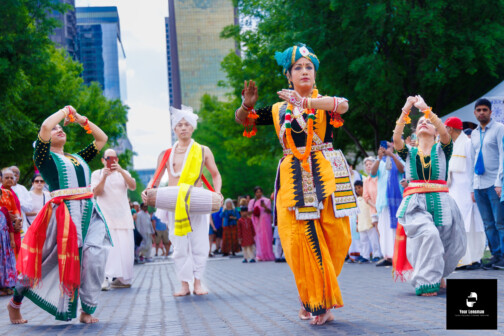 |
| LET THEM SHINE: Lighting directors Linda Blase, Tristan Decker, and Russell Dyer “paint” theater stages with dramatic lighting techniques. photography by Bode Helm |
When I see a play, I rarely notice lighting. Still less do I imagine the things these words signify: fresnels, ellipsoidal spotlights, cukes, gobos, light plots, snoots, twofers. Of the opulent workstuffs of the arts—the oils that make magenta and teal, the textures of muslin and tulle, the grain of teak or slate, the taut strings of the instruments that let out music, the whole astonishing palette of language—hardest for me to imagine as a substance, palpable and shapeable, is light. How can there be an art of light? What could it mean to “design” it?
Real as the question is, when I think back on the productions in Dallas that retain a satisfying form in my imagination, phenomena of light always have something to do with them. How that is, though, I could not have begun to say before talking to three of the best lighting designers in Dallas on the same day in late October. Afterward, some of those unrepeatable experiences began to glow mysteriously in retrospect.
Tristan Decker, Russell Dyer, and Linda Blase, known to every director in Dallas, have done the lighting for dozens of productions, but they all talk about the importance of not getting any attention.
“The best notice a lighting designer can ever get is no mention at all,” says Dyer, repeating what all lighting designers are taught. These artists have no false modesty. They know exactly what they’re doing and why. They remind me of what Joyce writes: “The artist, like the God of the creation, remains within or behind or beyond or above his handiwork, invisible, refined out of existence, indifferent, paring his fingernails.” At least neither Decker nor Dyer nor Blase, to their credit, mentions that God, according to a widely cited source, began his own creation by calling attention to the lighting.
Decker, who teaches at the University of Dallas, talks to me beside his desk in the Margaret Jonsson Theater, surrounded by detached stage lights, extension cords, catalogs, and assorted reusable mess. The place looks like the office in an electrician’s or mechanic’s shop, except for the brightly colored, hook-nosed masks for Volpone (which opened the next night) on his bookshelf.
Describing himself as a gadget nut, Decker is full of lore about lighting technology—“intelligent” or robotic lights, for example, whose dozens of “parameters” or properties he demonstrates for me. How did a UD drama major get interested in lighting? On a daring trip in 1995, during the heart of the war, when Undermain Theatre took a play called Sarajevo into Bosnia and he had to bring about stage effects with very basic equipment.
Thoughtful about what he does, Decker patiently explains everything from the “light plot”—a diagram showing each light and its exact placement above the stage—to the “light board” that lighting designers program to move between any number of “cues,” defined in David Hays’ book Light on the Subject as “the planned and timed operation of changing light levels.” He speaks carefully of the kind of art he practices.
“I perceive lighting design as more like sculpture?” Decker says, his quiet voice going up in the slight interrogative. “I see the beams of light, the cones of light, as a sculpture medium—the way the actors move through it.” He compares lighting design to the work of Dan Flavin, whose light sculpture retrospective appeared at the Modern Art Museum in Fort Worth in 2005.
“The colors of all the lights interact with each other,” he says, “but the space that they’re in can really change the feel of them. It’s kinetic; it’s alive. Turn the power off and it’s gone. That sculpture no longer exists. I think maybe that’s why the theater element appeals to me. Theater doesn’t last forever. We take art for granted, particularly the stuff that’s always there. Theater—you don’t have that choice. It forces me to keep thinking.”
When I talked to Russell Dyer half an hour later at the MAC, we sat at a table on the main stage with the large, garish, crucified Christ for Jesus Hates Me (the next play) already spookily presiding over the stage behind us. He was in the process of designing the lights for Theatre Three’s production of Glorious, but he still had to take down the lights from Kitchen Dog’s Fat Pig, so we met there. I wanted to know more specifics about the art of lighting, building on what Decker had already taught me. If the audience needs to notice the reaction of a character to something being said elsewhere on stage, how does a light designer do it? A film can simply cut from Gloria Swanson speaking to William Holden’s reaction. Not so in the theater, where the audience can look at anything they want to, even if noticing a certain reaction might be crucial.
“If you’re good, you know how to do it very subtly,” he says, obviously relishing the problem. “We’re directing the focus. All of a sudden, they’re staring over here at this, and they don’t know why. We’ve done that. We’ve pulled their eyes over here. We can do it very subtly—literally just brightening, changing, shifting color.”
Out at Dallas Children’s Theater on Skillman an hour later, Linda Blase says that doing the Halloween show she designed for Dallas Children’s Theater is typical of what a lighting designer does. “You read the script, you talk to the director, you watch some rehearsals, you notice the blocking, and you figure out what you need to do to make it look like what you want. Then you go to your paper and pencil and your very small inventory,” she says, laughing, “and figure out what you can do with what you’ve got, what you have to circuit together and what you don’t.”
She takes me through the set of Night of the Living Dead and shows me how the lights work with the attacking zombies. Then we go to the light board in a small room up behind where the audience sits, and she demonstrates what a “cue” looks like on the computer, explaining that each number on the screen—say from 1 to 35—signifies a particular light above the stage. Take light 19, for example, which focuses on a spot upstage left. She starts imagining how bright or dim it might be.
“Say I put it at 65,” she says, typing the figure in the box beneath the light’s number. “That brings it up to a level of 65 percent. Or if I decide I want more, I bring it up to, say, 88 percent, or maybe I want it less and I take it down to 18. Let’s say in the same cue, I want number 13 at 50 percent. Now I’ve got two lights up. Now say I want 1 through 3 at 65.” She enters it and shows me the array onscreen. “When I get all the levels the way I want them, I record the cue.”
It sounds simple, until you realize that in some “cue-heavy” plays—mostly contemporary ones—there might be 150 different cues to design and record. Russell Dyer talks about that part of the process as “painting,” the part that he does by himself at the computer and the light board. What he particularly likes is affecting the way an audience feels endings—the way the light fades around an actor. “If I can,” he says, “even though it happens in six seconds, I do it in seven cues. So this one particular light starts coming, the next one follows, and the next one, and you get this really incredible fadeout. It’s an emotional effect you’re trying to bring. You want to milk it as long as you can, but you also want to tell the audience we’re done. You’re really trying to heighten whatever emotion you can.”
I asked him about the very end of Fat Pig. Just after Tom (Ian Leson) tells Helen (Christina Vela) that he can’t overcome the social shame of being with her even though he loves her, they sit on the beach, just the two of them, and her future happiness gradually fades in the course of a minute or two, but goes out irrevocably in the last few seconds after the last line.
“What I was able to do is bring it in about six steps,” Dyer says. “Light starts sort of going out behind the audience. Hopefully, as an audience member, you don’t notice that, but something’s changing so you feel that it’s ending. I actually start that before the last line is delivered, so that you’re already into this slow feel—and then I just make it interesting.”
I can feel something begin to take shape, a startled recognition, like seeing for the first time what Shakespeare can do with metrical variations in a sonnet.
“You lose your angles and get down to your absolute last light,” he continues. “Even Ian’s out before Christina. I mean it’s instantaneous—not even a second. It might be that Ian went out .4 seconds before Christina did, but subconsciously, you know that it’s not Ian and Christina. It’s really Christina.”
Then darkness. Everything is illuminated.






